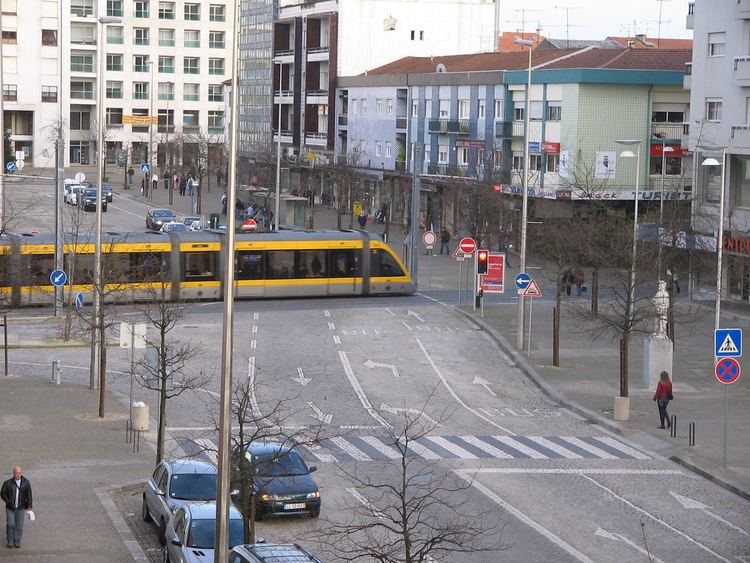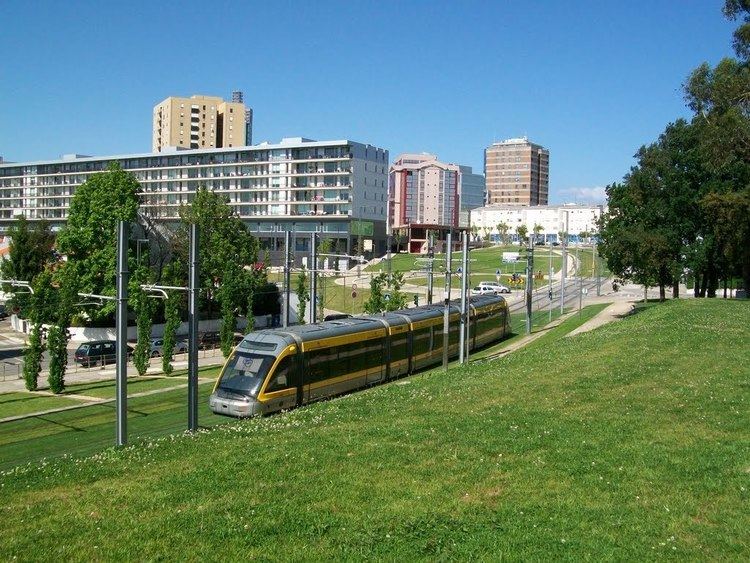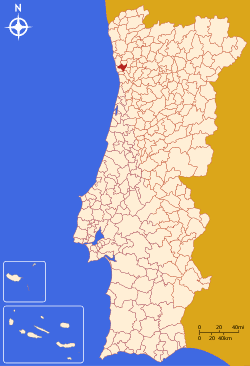Area 82.99 km² | Parishes 10 Population 135,306 (2011) Team Porto Renegades | |
 | ||
Weather 18°C, Wind E at 3 km/h, 57% Humidity | ||
Maia ([ˈmajɐ]) is a municipality in the Porto Metropolitan Area, Grande Porto subregion, in Norte Region, Portugal. The population in 2011 was 135,306, in an area of 82.99 km². There are one city (Cidade da Maia) and 3 towns (Moreira, Castêlo da Maia and Águas Santas) in the municipality.
Contents
- Kiley boynton ryan ward balance routine acro world cup 2014 maia portugal
- History
- Economy
- Education
- Transportation
- International relations
- Sports
- Famous inhabitants
- Parishes
- References

Kiley boynton ryan ward balance routine acro world cup 2014 maia portugal
History

The area of the current municipality (concelho) is inhabited since millennia ago. The human occupation dates from the Paleolithic. In many hills of the region, there were found remains of villages from the Iron Age. Attracted by rich soil and abundance of resources, the Romans also left out visible marks of their occupation. In the middle of the thirteenth century, the Lands of Maia (Terras da Maia) extended from the city of Porto until the Ave river and from the sea to the mountains. In 1304, however, the Lands of Maia were incorporated into those of Porto, losing its political and administrative autonomy. In 1360, King Pedro I of Portugal gave the landlord of Azurara (in current Vila do Conde), with Lands of Maia, to the infant D. Dinis, his son. The history of this municipality is also closely linked to the founding of the Portuguese nation. Some authors argue that even the Prince Afonso Henriques has been educated here, next to the family of Mendes da Maia, who belonged to the Arcebishop of Braga D. Paio Mendes and the famous warrior Gonçalo Mendes da Maia, the "Lidador" (today the hero of the city), so named for having entered into fearless struggle against the Saracens. In the Age of Discovery, the region of Maia produced candles and fabrics for use in the Portuguese caravels. At the beginning of the sixteenth century, the King Manuel I of Portugal granted the charter, which provided the rent to be paid to the donee Reguengos of Maia, and regulated how to carry out punishments and courts. Between the years of 1700 and 1836, the county was composed of 44 parishes and encompassed the entire range between the sea and the Leça and Ave rivers. With administrative reforms initiated in 1836, Maia became a separate municipality, but reduced both in area and number of parishes. In 1857, the municipality of Maia was even extinct. It was necessary to wait until 1868 to see it restored. Maia municipality was crossed in 1809 by the Napoleonic army of the Duke of Dalmatia, the Marshal Soult, which was going from Braga to Porto. Between 1832 and 1834, in the turbulent years of struggles and civil war opposing Miguel of Portugal to Pedro IV of Portugal, it was the scene of bloody battles between the absolutist and the liberal factions.
Economy

Maia Municipality is one of the most industrialized in the Norte Region. Among its industries are Sonae Indústria, a leading wood-based products company; market leader for paint & coating products CIN; fruit processing company Frulact; and cereal processing company Cerealis, which are headquartered in the municipality. Other industries include textiles, chemicals, mechanical equipment and food products (e.g. Ferbar - Fernando Barros Productos Alimentares, Lda., a major Portuguese wholesaler of food products). Sonae SGPS, owner of one of the largest hypermarket chains and the largest private employer in Portugal, is also headquartered in Maia. CEIIA - Centro para a Excelência e Inovação na Indústria Automóvel (auto industry innovation center), is located in TECMAIA (Parque de Ciência e Tecnologia da Maia complex), a science park situated in the Maia Industrial Zone.
Education

Maia has a comprehensive network of pre-school, primary, and secondary education. In addition, Maia is home of ISMAI - Instituto Superior da Maia, a private institution of higher education awarding degrees in fields ranging from psychology to communication sciences to physical education & sports to accountancy to information systems & software. In addition, Maia's population is served by the major higher education institutions located in the neighbouring municipality of Porto, including the University of Porto.
Transportation
The Porto International Airport, Francisco Sá Carneiro Airport (also known as Pedras Rubras Airport) is located in the parish of Moreira, in Pedras Rubras. The municipality is also served by Metro do Porto (Porto's Metro).
International relations
The following places are sister cities to Maia:
Sports
Maia is the hometown of two important sports organizations: the football club FC Maia, and the cycling team União Ciclista da Maia.
Famous inhabitants
Parishes
Administratively, the municipality is divided into 10 civil parishes (freguesias):
